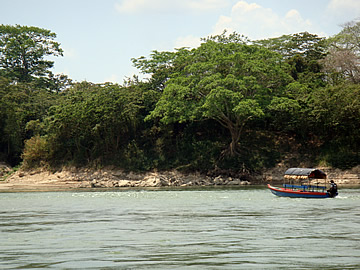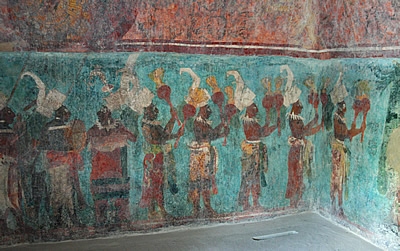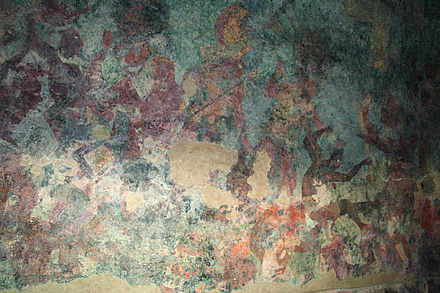


Bonampak is a small Mayan site with incredible frescoes, the best-preserved from the ancient Mayan world.


Our entry to Mexico was on the Usumacinta River from Bethel in Guatemala to Frontera Corozal on the Mexican side. We were taken on a motorised canoe by our guide and the boat's owner. These low canoes are a great way to travel, quite speedy and cool. So low on the water you feel part of the landscape.

The river is wide and slow-moving, with dense vegetation crowding down almost to the edge. The shore is generally rocky with a steep rise behind - presumably marking the extent of the flood plain.

We passed lots of ladies doing their washing in the old traditional way, at the river's edge and hard at work.
Fifteen minutes and we were at Corozal. Things did not go smoothly. No-one was there to meet us but a guide from the company was said to be arriving soon. Our Guatemalan guide left and we waited - and waited. No-one came. Normally this wouldn't be a problem but we hadn't gone through any customs procedures and hadn't a clue what to do. Eventually we got through to the company who were supposed to be sorting things out. No-one was scheduled to come. They'd expected the Guatemalan guide to take care of the customs formalities.


In the end we went to the immigration office ourselves and sorted it out. It was quite straightforward and quick fortunately.

We were staying at Escudo Jaguar, an extremely basic hotel where we were lodged in cabins with ceiling fans and mosquito netting stretched across the roof space which disappeared up to the thatched roof. It was fine for one night and at least the electricity didn't go off.
There was almost a full moon and the howler monkeys began their cacophany but they were some distance away so didn't disturb us.
The following morning we took a walk down to the river but it was already hot before 9 a.m. so we returned to our cool room until it was time to set off in another motorised canoe to visit Yaxchilan and Bonampak.

The final 10km of our journey to Bonampak had to be by a minibus operated by the local Lacandon people. The site stands on their land and they don't allow outside cars to be driven in.
Where Yaxchilan is famous for its carved lintels, Bonampak is celebrated for the most beautiful, colourful frescoes. Throughout the Mayan world very few frescoes have survived to be seen today.
This is a small site, no bad thing after some of the enormous Mayan cities we have seen, surrounded by dense jungle and very nice to stroll around.

Essentially we saw the late Classic-era Grand Plaza, oriented south-west north-east, with remains of minor buildings on the south-west side. On the north-east side an extensive stepped terrace leads to several small buildings.


The great king Chaan-Muan II, ruling in the late eighth century, is celebrated in both stelae and murals, and is responsible for much of what can be seen. Not too far from Yaxchilan, Bonampak was inevitably closely aligned with it. Chaan-Muan was married to the Yaxchilan ruler Bird Jaguar's sister.

In the middle of the Grand Plaza stands the large Stela 1, at around six metres high. Chaan-Muan is depicted in elaborate clothing, not as a warrior, more as a powerful lord, which he undoubtedly was.






Chaan-Muan also features on Stelae 2 and 3 on the lower steps of the terrace. On Stela 2 he is shown preparing for a blood ritual with his wife and mother. His wife was sister to the ruler of Yaxchilan, no doubt a marriage to promote allegiance.1
In Stela 3 a prisoner kneels at the feet of Chaan-Muan, probably the victim in the blood-letting ceremony.
But the real stars of this site are the murals, housed in a building, Structure 1, half way up the stepped terrace. This was originally adorned with stucco scenes and statues in niches. In each of three rooms a set of murals covering the walls depicts a different scene in a royal narrative.
No flash is allowed, of course, so the photographs are a little blurred but give some idea of what is to be seen.

In the first room the frescoes on the upper walls depict the ruler's son being presented to the nobles, who are all looking away and don't seem at all interested!


On the lower walls an exotic procession includes dancers and musicians. The ceremony would be to establish the true line of succession.
The array of exotic costumes and head-dresses is fabulous, when newly painted it must have been dazzlingly colourful.




This room also has a fine lintel above the entrance showing a warrior attacking a fallen enemy.

The Maya believed that images lose their power if eyes, or even whole faces, are scratched out and we saw much evidence of that at Bonampak.



In the second room a huge vibrant battle takes place showing scenes of torture, the king looking rather aloof. It's possible that the ceremony in the first room preceded this battle so that if the king were killed the line of succession would be clear. This would be even more important when the heir is a young child.



The entrance to Room 2 also has a carved lintel showing a similar scene to that in Room 1 but it is in poorer condition.
The murals in the first room are in excellent condition, those in the second room not quite so good. The third room, showing scenes of blood sacrifice2, was closed for preservation works which will take about three years.

After marvelling at the colourful frescoes we had some time just to wander around the site as the sun dipped lower in the sky, before beginning the drive to Palenque.

